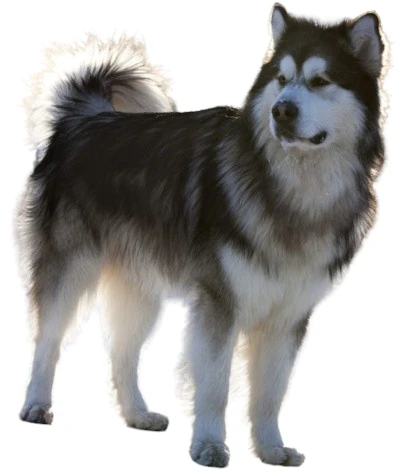
The Alaskan Malamute is a large dog breed known for its strength, endurance, and majestic appearance. Originating from Alaska, this breed was developed by the Malemiut, an Inuit tribe, to pull heavy sleds over long distances in extreme weather conditions.
Physically, the Alaskan Malamute is an imposing and muscular dog. Males typically measure between 63 and 71 cm at the withers, while females measure between 58 and 66 cm. Their weight ranges from 38 to 56 kg for males and 32 to 45 kg for females. Their body is robust and well-proportioned, with a broad, deep chest and a straight, powerful back. The head of the Alaskan Malamute is broad with a slightly rounded skull, almond-shaped dark brown eyes expressing a gentle and intelligent expression, and triangular ears that are erect and slightly inclined forward.
The coat of the Alaskan Malamute is dense and double-layered, with a soft, thick, and woolly undercoat and a longer, slightly coarse outer coat. The coat is well-suited to the harsh Arctic climate, providing excellent insulation. Coat colors vary and include combinations of light gray, black, red, and sable, often with white markings on the face, legs, and belly. Regular grooming is necessary to maintain the health and appearance of the coat, especially during seasonal shedding periods.
In terms of personality, the Alaskan Malamute is known for its friendly, sociable, and independent temperament. It is very attached to its family and shows great loyalty but can be reserved with strangers. Its independent nature and strong work instinct require early socialization and training to ensure balanced behavior. The Alaskan Malamute is a playful and affectionate dog but can be stubborn and needs an experienced owner capable of providing firm and consistent leadership. Due to its pack instinct, it generally gets along well with other dogs but may have a strong prey drive towards small animals.
The Alaskan Malamute is an active breed that needs plenty of exercise to stay physically and mentally healthy. It enjoys long walks, hikes, and activities that stimulate its mind and body. Due to its size and weight, it is important not to overexert it, especially during its growth period. In terms of health, the Alaskan Malamute is generally robust, but like all large breeds, it can be prone to certain health issues such as hip dysplasia, eye disorders, and cardiac problems. A balanced diet, regular veterinary care, and appropriate exercise are essential to maintaining its overall health.

The Alaskan Malamute Puppy is a strong and powerful dog, originating from arctic regions, primarily used for pulling heavy loads. With its dense, thick coat, it is well-suited for cold climates. The Alaskan Malamute is an affectionate, sociable dog, very attached to its family, although it has an independent temperament. This intelligent dog requires firm and consistent training from an early age, along with ample opportunities for physical exercise. It enjoys outdoor activities and adapts well to active families, especially those with outdoor space.
The price of an Alaskan Malamute Puppy varies depending on the breeder, pedigree, and location. On average, expect a budget of around 1,200 to 1,800 euros.
The Alaskan Malamute, a powerful and independent sled dog, requires firm but kind training from an early age due to its strong personality.
Its pronounced pack instinct demands clear hierarchy: the owner must establish leadership naturally and consistently without violence.
Highly intelligent but stubborn, it responds better to positive methods (games, food rewards) than tedious repetitions. Varying exercises is essential.
Its intense exercise needs (minimum 2 hours/day) should be channeled: incorporate obedience into pulling sessions, hiking or canicross to stimulate it physically and mentally.
Early socialization is crucial to control its natural dominance toward other animals. Supervised encounters should be frequent.
Its independence makes recall challenging: use training leashes before off-leash freedom, and practice this command in varied environments.
Adapt your voice (low, confident tone) and posture to its sensitivity to nonverbal cues. Short, consistent commands work better than long phrases.